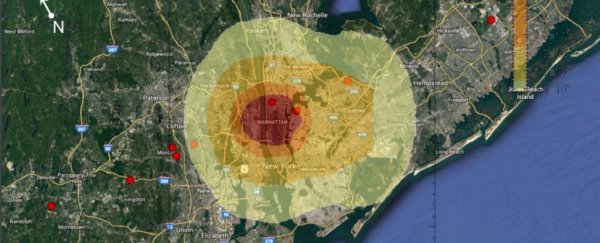On 29 April, 2027, a terrible and world-changing event occurred.
A 60-metre (200-foot) asteroid called 2019 PDCentered Earth's atmosphere at a shocking speed of 19 kilometres per second (43,000 mph) and impacted over New York's Central Park.
Up to 20 megatons of energy were released in the airburst – 1,000 times the energy of the nuclear bomb dropped on Hiroshima.
That asteroid was, of course, hypothetical; but one day it could be a real scenario.
Over the last week, a group of space experts, including those from NASA, the Federal Emergency Management Agency (FEMA), and the European Space Agency (ESA), came together and conducted a simulation experiment to test our management of this sort of impending disaster.
Yeah, we didn't do great.
The experiment, called the IAA Planetary Defense Conference, ran over five days, but the timeframe was 8 years – we discovered the hypothetical asteroid on 26 March 2019, so the world had nearly a decade before the impact to work out what to do.
In the hypothetical scenario, by 2021 NASA had sent out a reconnaissance mission to find out more about the asteroid's size, orbit, and composition.
Then, in 2024, three probes were sent to crash into the space rock to hopefully push the asteroid away.
Although the main body was deflected, a 50-80 metre fragment broke off and was still on track to collide with Earth.
According to AFP, Washington considered using a nuclear bomb to deflect the rock, but the idea never got off the ground due to political disagreements.
So, people were evacuated, and the asteroid hit on 29 April 2027.
#FictionalEvent
— ESA Operations (@esaoperations) May 3, 2019
The small (fictional!) asteroid #2019PDC will enter Earth’s atmosphere at 19 km/s (43,000 mph) on April 29, producing a large fireball or “megabolide,” and predicted to release 5 to 20 megatons of energy in the airburst. pic.twitter.com/EpiQS1JwGb
An impact of that scale would flatten a 15-kilometre radius, completely destroying Manhattan. The airburst would mean no survivors within 20,480 acres (32 square miles), with damage extending as far as 68 kilometres from the collision point.
For contrast, 9/11 destroyed 16 acres which created US$2 trillion in total economic damage.
But did we learn anything? These scenarios create endless questions, such as how long we would need to evacuate that many people, where they would go, and how we would protect things like nuclear facilities.
Managing such a disaster requires a lot more than just experts dealing with the scenario in space. Running these simulations will help explore potential answers to the many logistical problems on the ground as well. For example, how would citizens behave during such a disaster?
"If you knew your home was going to be destroyed six months from now, and that you weren't going back again, would you keep paying your mortgage?" asked Victoria Andrews, NASA's deputy planetary defence officer, reports AFP.
#FictionalEvent
— ESA Operations (@esaoperations) May 3, 2019
...to finalize the evacuation of residents & critical infrastructure, define a Temporary Flight Restriction zone, coordinate pre-impact access to the area by scientists placing sensors to monitor the impact, prepare for any casualties & recovery#PlanetaryDefense pic.twitter.com/yqHKlsyL3q
As the ESA blog explains, asteroid impacts are the only natural disaster we have the power to prevent, and which we can find out about years or decades in advance.
Current technologies - such as powerful telescopes around the world and the Near-Earth Object Coordination Centre - are helping discover potentially problematic asteroids, while future technologies – like NASA's DART spacecraft – will be instrumental in protecting ourselves.
"The first step in protecting our planet is knowing what's out there," Rüdiger Jehn, ESA's Head of Planetary Defense, explained at the start of the week.
"Only then, with enough warning, can we take the steps needed to prevent an asteroid strike altogether, or to minimise the damage it does on the ground."
